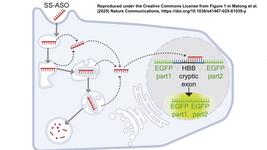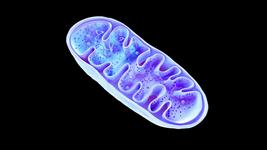CMN Weekly (27 May 2022) - Your Weekly CRISPR Medicine News
By: Karen O'Hanlon Cohrt - May. 27, 2022
Top pick
- In an article published this week in Hepatology Communications, scientists in Japan report that inhibition of non-homologous end joining (NHEJ)-mediated DNA repair enhances anti-hepatitis B virus (HBV) CRISPR therapy. Currently available HBV therapies do not eliminate HBV, partially owing to their minimal effect on covalently closed circular DNA (cccDNA, a special DNA structure that can during the propagation of certain viruses in the host cell nucleus). The team hypothesised that inhibition of the NHEJ pathway, which is important for the repair of CRISPR-induced double-strand breaks, may enhance the effect of CRISPR targeting cccDNA. They therefore investigated the antiviral effect of potential combination therapy by targeting cccDNA with CRISPR and inhibiting NHEJ with the approved PARP inhibitor olaparib. The team proposes that CRISPR and olaparib treatment in combination may represent a new therapeutic avenue for HBV elimination.
Research
- In a manuscript shared on the pre-print server BioRxiv, researchers at University of Illinois Urbana-Champaign describe the use of CRISPR base editors to perturb gene expression via targeted mutagenesis of cis-acting sequences. Using the promoter region of the human huntingtin (HTT) gene as an initial target, they show that editing of the binding site for the transcription factor NF-κB led to a marked reduction in HTT gene expression in base-edited cell populations. The team found that base-editor-induced gene perturbations were persistent and specific, and they further demonstrate that the platform could influence gene expression in vivo in a mouse model of Huntington's disease.
- Yesterday, researchers at various institutes in the U.S. shared experimental findings in Molecular Cell that call into question previously published work by researchers in China (in 2020, in Molecular Cell), who claimed to have identified 7 anti-CRISPR protein (Acr) families (AcrVIA1-7) that inhibit type VI-A CRISPR systems.
- Researchers in the U.S. report exploiting the ability of Type III-A CRISPR-Cas systems to perform RNA-guided and sequence-specific target RNA cleavage to establish research tools for post-transcriptional control of gene expression. After expressing Type III-A systems from three bacterial species on a single plasmid in E. coli and assessing the efficiency and specificity of gene knockdown by Northern blot and transcriptomic analysis, the team found that engineered Type III-A modules can be programmed using tailored gRNAs to efficiently knock down gene expression of both coding and non-coding RNAs in vivo. The findings were published in RNA yesterday.
- A team from San Raffaele Telethon Institute for Gene Therapy in Italy has shown that mobilisation-based chemotherapy-free engraftment of gene-edited human haematopoietic stem cells (HPSCs) creates an opportunity for seamless engraftment of ex vivo gene-edited cells that can then repopulate the depleted bone marrow following prior myeloablative conditioning therapy. They demonstrate the therapeutic efficacy of their approach in a murine model of hyper IgM syndrome and further developed it in human haematochimeric mice, showing its applicability and versatility when coupled with gene transfer and editing strategies. The findings were published recently in Cell.
- Scientists from Cornell University reported in Science yesterday that they have elucidated the structural basis for RNA-guided DNA cleavage by IscB-ωRNA and they make a mechanistic comparison with Cas9. According to the authors, Class 2 CRISPR effectors Cas9 and Cas12 may have evolved from nucleases in IS200/IS605 transposons, where IscB is about 40% the size of Cas9 but shares similar domain organisation, and the associated ωRNA plays the combined role of crRNA and tracrRNA to guide dsDNA cleavage. The authors report a 2.78 Å cryo-EM structure of IscB-ωRNA bound to dsDNA target, revealing the architectural and mechanistic similarities between IscB and Cas9 ribonucleoproteins.
Detection
- Researchers in China describe their discovery of a "RESET" effect (random extending sequences enhance trans-cleavage activity) for the activation of CRISPR-Cas12a trans-cleavage activity. Specifically, they report that a single-stranded DNA, which is too short to work as the activator, can efficiently activate CRISPR-Cas12a after being extended a random sequence from its 3'-end, even when the random sequence folds into secondary structures. The authors claim that the discovery of this "RESET" effect increases the potential for CRISPR-Cas12a-based sensing strategies. Using their new discovery, they designed two new CRISPR-Cas12a-based biosensors for the sensitive and specific detection of two biologically important enzymes. The findings were published yesterday in Analytical Chemistry.
- Scientists in Japan have developed an automated amplification-free digital RNA detection platform for SARS-CoV-2 using CRISPR-Cas13a and a microchamber device (opn-SATORI), which automatically completes a detection process from sample mixing to RNA quantification in clinical specimens within ~9 min. The team found that, using an optimised Cas13a enzyme and magnetic beads technology, they could detect SARS-CoV-2 genomic RNA with a limit of detection of < 6.5 aM (3.9 copies μL-1), which is comparable to the detection limit of the gold standard real-time quantitative PCR. They also report that opn-SATORI could discriminate between SARS-CoV-2 variants of concern, including alpha, delta, and omicron, with 98% accuracy. They claim that opn-SATORI can serve as a rapid and convenient diagnostic platform for several types of viral infections. The findings were published yesterday in Communications Biology.
Reviews
- Current and Possible Future Therapeutic Options for Huntington's Disease. This comprehensive review by authors in New Zealand and Ireland aims to discuss the efficacy of current Huntington's disease (HD) treatments and explores the clinical trial progress of emerging potential HD therapeutics. The review also includes a discussion about potential new HD therapies in pre-clinical development include zinc-finger protein (ZFP) therapies, TALEN-based therapies and CRISPR-based therapies.
- Dead Cas(t) light on new life: CRISPRa-mediated reprogramming of somatic cells into neurons. In this review, scientists in China discuss the latest progress, new insights, and future challenges of the application of the catalytically-dead Cas9 (dCas9) system in direct neuronal reprogramming of terminally differentiated somatic cells.
- Targeted therapies in non-small cell lung cancer and the potential role of AI interventions in cancer treatment. Scientists in India provide an overview of recent developments in cancer immunotherapy, which can be used in first- and second-line treatments in the clinic. They also discuss the contribution of technology based on Artificial Intelligence (AI) to detect tumours early on in cancer, using machine-learning techniques.
- CRISPR-Based Genome-Editing Tools for Huntington's Disease Research and Therapy. In this review, scientists in China examine the development of CRISPR-based genome-editing tools and their applications in Huntington's disease (HD) to offer a translational perspective on advancing genome-editing technology to actual HD treatments.
News from CRISPR Medicine News
- Monday's feature was about the use of CRISPR to revive T cell receptor therapy for the treatment of multiple cancer types. We interviewed researchers from Italy’s Ospedale San Raffaele Scientific Institute who, in collaboration with Intellia Therapeutics, used CRISPR to introduce multiple genomic edits to T cells, creating a T cell receptor therapy candidate with potent activity against haematological and solid tumours.
- In Wednesday's clinical update, we brought news about positive clinical data from Caribou Bioscience's ongoing ANTLER Phase 1 clinical trial for its CRISPR-edited CAR-T cell therapy, CB-010. CB-010 is being developed as a CD-19 targeting CAR-T cell therapy to treat relapsed/refractory B cell non-Hodgkin lymphoma, and it is the first allogeneic CAR-T cell candidate to achieve a clinical response in all patients evaluated.
Huh, heh, wow
- Thanks to CRISPR, things are looking up for the approximately one billion people worldwide who suffer from vitamin D insufficiency. In an article published in Nature Plants this week, researchers in the UK, Italy, Chile and Cuba report using CRISPR to engineer the accumulation of provitamin D3 in tomatoes. According to the authors, the result of their work is a biofortified food as well as the added possibility of supplement production from waste material.
To get more of the CRISPR Medicine News delivered to your inbox, sign up to the free weekly CMN Newsletter here.
Tags
CLINICAL TRIALS
IND Enabling
Phase I
Phase II
Phase III
Recurrent or Progressive High-grade Glioma, (NCT06737146)
Sponsors:
Suzhou Maximum Bio-tech Co., Ltd.
Sponsors:
Suzhou Maximum Bio-tech Co., Ltd.
IND Enabling
Phase I
Phase II
Phase III
Advanced Peritoneal Malignancies or Abdominal Metastatic Solid Tumors, (NCT06912152)
Sponsors:
Zhejiang University
Sponsors:
Zhejiang University
IND Enabling
Phase I
Phase II
Phase III







